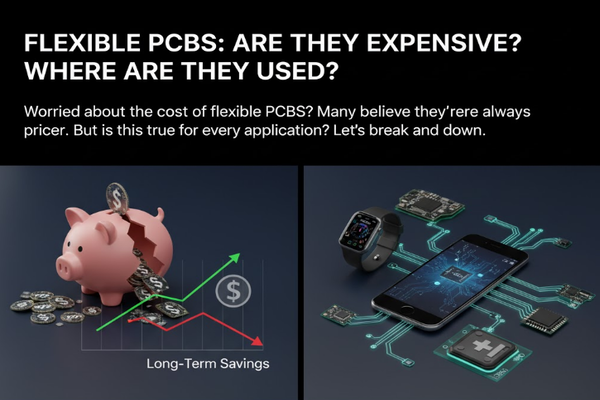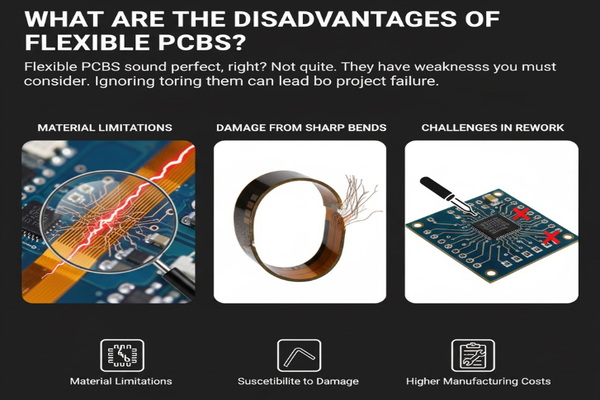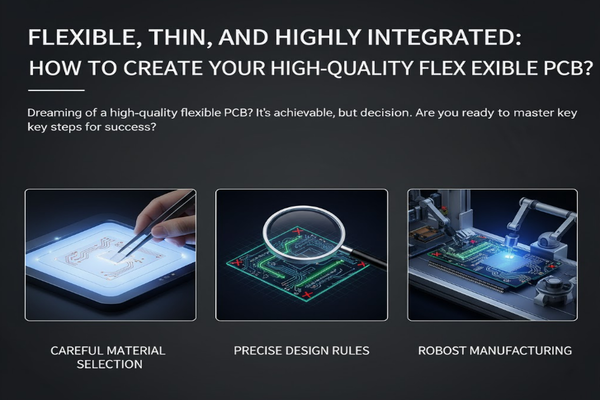Flexible PCBs offer amazing possibilities, but they come with challenges. Ignore these, and your project could fail. Are you ready to uncover the crucial mistakes?
Flexible PCBs1 can fail due to wrong materials2, poor design choices3 like asymmetric layering4 or sharp traces near bends5, and insufficient testing6 for mechanical stress, impacting reliability and performance7.
When I first started working with flexible PCBs, I thought they were a magic bullet. Compact, versatile, and seemingly simple. But I quickly learned that behind their apparent simplicity lay a minefield of potential issues. My journey taught me that understanding these common pitfalls is not just helpful, it’s essential for anyone diving into flexible electronics. So, let’s explore these challenges together.
Are Flexible PCBs Expensive? Where Are They Typically Used?
Worried about the cost of flexible PCBs? Many believe they’re always pricier. But is this true for every application? Let's break it down.
Flexible PCBs can be more expensive than rigid boards initially but offer long-term savings through compact design and reduced assembly. They are widely used in smartphones8, wearables, medical devices9, and automotive applications10.

The cost of flexible PCBs11 isn't always straightforward. While tooling and material costs can be higher than rigid boards, their ability to integrate into complex, space-constrained designs often leads to overall system cost reductions. Consider the following factors:
Cost Comparison: Flexible vs. Rigid
| Feature | Flexible PCB (typically) | Rigid PCB (typically) |
|---|---|---|
| Material | Polyimide, LCP | FR-4 |
| Tooling | Higher initial | Lower initial |
| Assembly | Potentially lower | Higher for complex 3D |
| Space Save | Significant | Limited |
| Reliability | Excellent in dynamic use | Good in static use |
Flexible PCBs shine in areas where space is critical or dynamic bending is required. For instance, in a foldable smartphone, a rigid board simply wouldn't work. I've seen projects where a flexible PCB eliminated multiple connectors and cables, reducing assembly time and improving reliability, despite a higher unit cost for the bare board itself. This integration capability makes them invaluable in consumer electronics, automotive sensors, and advanced medical implants.
What are the Disadvantages of Flexible PCBs?
Flexible PCBs sound perfect, right? Not quite. They have weaknesses you must consider. Ignoring them can lead to project failure.
Flexible PCBs can suffer from material limitations, susceptibility to damage from sharp bends, challenges in rework, and higher manufacturing costs, making careful design crucial.

Despite their advantages, flexible PCBs present several notable disadvantages. My early experiences taught me that these downsides, if not properly managed, can easily derail a project.
Common Flexible PCB Disadvantages
- Material Limitations:
- Incompatible Materials: Using the wrong type of copper or substrate, like a polyimide not suited for high-temperature processes or dynamic flexing, can lead to immediate failure or reduced lifespan. I've seen cases where a cheaper copper foil, not designed for the stresses of bending, delaminated after only a few cycles.
- Asymmetric Layering: Asymmetric stack-ups in multi-layer flexible PCBs are a silent killer. This design flaw easily causes warping, bowing, or delamination during manufacturing and assembly. The unbalanced stress across the layers pulls the board out of shape.
- Design Constraints:
- Stress Concentration: Placing pads or vias too close to bend areas is a critical mistake. When the board flexes, these points experience extreme stress, leading to cracked traces or broken connections. I learned to always provide ample clearance from any bend line.
- Sharp Angles: Acute angled traces might look neat on paper, but they are stress concentrators. When the board flexes, these sharp corners become weak points, leading to trace fractures. Always opt for rounded corners or tear-dropping for improved stress distribution.
- Manufacturing and Testing:
- Rework Difficulty: Repairing flexible PCBs is significantly harder than rigid boards due to their delicate nature and thin materials. Once damaged, they often require complete replacement.
- Mechanical Stress: Flexible boards are constantly subjected to mechanical stresses. Therefore, testing must go beyond simple electrical continuity. Bending endurance tests are essential to ensure the board can withstand its intended application over time. I've found that neglecting bend fatigue testing is a recipe for field failures.
Flexible, Thin, and Highly Integrated: How to Create Your High-Quality Flexible PCB?
Dreaming of a high-quality flexible PCB12? It's achievable, but demands precision. Are you ready to master the key steps for success?
Creating a high-quality flexible PCB requires careful material selection, precise design rules to avoid stress points, and robust manufacturing processes that account for the board's unique mechanical properties.

Achieving a high-quality flexible PCB design requires a holistic approach, considering materials, design, and manufacturing in concert. My experience has shown me that cutting corners in any of these areas will inevitably lead to headaches.
Steps to High-Quality Flexible PCB
| Stage | Key Considerations | Impact on Quality |
|---|---|---|
| 1. Materials | Substrate: Choose polyimide (PI) or liquid crystal polymer (LCP) based on flexibility, temperature, and electrical needs. Conductor: Use rolled annealed (RA) copper for dynamic flexing. Adhesive: Select appropriate adhesive for bond strength and temperature. | Wrong material choices lead to delamination, cracking, or poor electrical performance. RA copper prevents trace cracking in dynamic applications. |
| 2. Design | Layer Stack-up: Ensure balanced, symmetric layer arrangement to prevent warping. Bend Radius: Adhere to minimum bend radii guidelines for materials. Stress Relief: Implement teardrops on pads and vias, and use smooth, curved traces near bend areas. Component Placement: Avoid placing heavy or rigid components in flex zones. | Poor design creates stress points, leading to fatigue failures. Asymmetric designs warp, causing assembly issues. Incorrect bend radii exceed material limits, causing immediate damage. |
| 3. Manufacturing | Process Control: Maintain strict control over etching, lamination, and drilling. Yield Management: Account for material stretch and shrinkage during fabrication. Testing: Conduct thorough electrical and mechanical tests, including bend cycle testing and vibration analysis. | Inconsistent processes introduce defects. Lack of mechanical testing means the board might not survive its intended use. Proper compensation for material changes ensures dimensional accuracy. |
I've personally seen how a small change in trace routing – simply making a sharp corner into a curve – dramatically improved the durability of a flexible PCB in a high-flex application. It's these subtle but critical details that define a high-quality flexible design.
How to Choose a Flexible PCB Supplier?
Finding the right flexible PCB supplier is crucial for success. Make the wrong choice, and your project faces delays and defects. Learn how to pick the best.
Choosing a flexible PCB supplier requires evaluating their experience with flex designs, manufacturing capabilities, quality control processes, and ability to provide comprehensive support and testing.

Selecting a reliable flexible PCB supplier is as critical as the design itself. A great design can be ruined by a subpar manufacturer. I learned this the hard way on an early project where cost-cutting led to choosing a vendor without specialized flex expertise, resulting in unacceptable yield rates and project delays.
Supplier Evaluation Criteria
| Category | Key Questions and Checks | Why it Matters |
|---|---|---|
| 1. Expertise & Experience | Do they specialize in flexible PCBs, or is it a sideline? How long have they been manufacturing flex? Can they provide case studies or examples of complex flex designs they've successfully produced? What kind of engineering support do they offer during design review? | Flexible PCBs have unique manufacturing challenges. A specialist understands these nuances and can offer valuable DFM (Design for Manufacturability) feedback. Generalists might overlook critical flex-specific issues. |
| 2. Manufacturing Capabilities | What types of flexible PCBs can they produce (e.g., single-sided, double-sided, multi-layer, rigid-flex)? What are their tolerances for trace width, spacing, and drill size? Do they have in-house capabilities for specialized processes like laser drilling or plasma etching? What material options do they stock? | The supplier must match your design's complexity. Their capabilities directly impact what you can design. Limited options might force design compromises or lead to outsourcing, increasing lead times and costs. |
| 3. Quality Control & Testing | What quality certifications do they hold (e.g., ISO, IATF)? What testing procedures are in place for flexible PCBs (e.g., bend cycle testing, impedance control, thermal cycling)? How do they handle non-conforming materials or products? Can they provide detailed test reports for each batch? | Quality is paramount, especially for flex, which often goes into demanding environments. Robust QC and specialized flex testing ensure the boards meet performance and reliability requirements. My personal rule: if they don't do bend testing, walk away. |
| 4. Communication & Support | How responsive are they to inquiries? Do they have a dedicated project manager or technical contact? What is their process for design revisions and change orders? Can they offer quick-turn prototypes? | Clear and timely communication prevents misunderstandings and keeps projects on track. Good support is essential for resolving unexpected issues quickly, which are common in complex flex PCB development. |
My advice: don't just look for the cheapest option. Investigate their track record, ask tough questions, and ideally, visit their facility or speak with their other clients.
Conclusion
Explore the advantages of flexible PCBs and how they can enhance your electronic designs. ↩
Learn about the critical impact of material selection on PCB performance and reliability. ↩
Understand the design pitfalls to avoid for successful PCB projects. ↩
Discover how asymmetric layering can affect the integrity of your flexible PCB. ↩
Find out how sharp traces can lead to failures in flexible PCB applications. ↩
Learn about the essential testing methods to ensure the reliability of flexible PCBs. ↩
Explore the relationship between flexible PCB design and overall product performance. ↩
Discover the role of flexible PCBs in the latest smartphone technologies. ↩
Learn how flexible PCBs are revolutionizing the medical device industry. ↩
Explore the innovative uses of flexible PCBs in modern automotive technology. ↩
Get insights into the cost dynamics of flexible versus rigid PCBs. ↩
Explore the key steps to achieve a high-quality flexible PCB design. ↩



